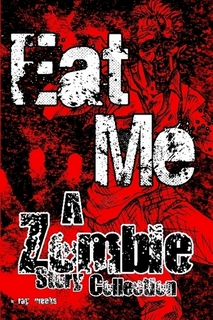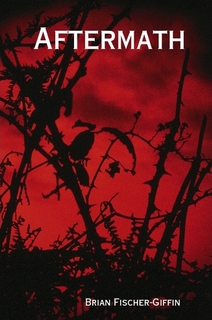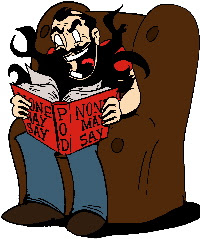 Just a quick note that I've posted a review of Modern Man by E.J. Lonergan over at The Strangelands, so check it out over there. (The Strangelands is the website of author Ray Weeks, whose books The Adventures of Portly Boy and Eat Me I've previously reviewed.)
Just a quick note that I've posted a review of Modern Man by E.J. Lonergan over at The Strangelands, so check it out over there. (The Strangelands is the website of author Ray Weeks, whose books The Adventures of Portly Boy and Eat Me I've previously reviewed.)
Sunday, February 07, 2010
Review Posted Elsewhere: Modern Man by E.J. Lonergan
 Just a quick note that I've posted a review of Modern Man by E.J. Lonergan over at The Strangelands, so check it out over there. (The Strangelands is the website of author Ray Weeks, whose books The Adventures of Portly Boy and Eat Me I've previously reviewed.)
Just a quick note that I've posted a review of Modern Man by E.J. Lonergan over at The Strangelands, so check it out over there. (The Strangelands is the website of author Ray Weeks, whose books The Adventures of Portly Boy and Eat Me I've previously reviewed.)
Saturday, November 28, 2009
FreeBooks #11: Snapdragon Alley by Tom Lichtenberg
 Tom Lichtenberg writes curiously engaging novellas. His stories are not driven by action but by mood and metaphysics. His premises often begin with fairly standard, often vaguely science-fiction concepts: time travel in Time Zone, for example, or mind control in World Weary Avengers. But he spins those concepts out into melancholy, thoughtful tales.
Tom Lichtenberg writes curiously engaging novellas. His stories are not driven by action but by mood and metaphysics. His premises often begin with fairly standard, often vaguely science-fiction concepts: time travel in Time Zone, for example, or mind control in World Weary Avengers. But he spins those concepts out into melancholy, thoughtful tales. Lichtenberg cares little about the mechanics of the MacGuffins that underlie his stories. Rather, he explores the emotion and (often) dislocation that people feel when confronted by something outside their normal experience. In Somebody Somewhere that "something" is as commonplace (relatively speaking) as a kidnapping and hostage situation; in Time Zone, as noted above, the "something" is as vast an incomprehensible as travel through time. Lichtenberg's characters may adapt to the situation or ignore it, or become totally overwhelmed; but the true story is always in those emotions and responses, rather than the rote turnings of some formulaic plot device. Although Lichtenberg's spare, quiet style could not be more different than H.P. Lovecraft's ornate verbal extravagance, the two share a conceptual interest in exploring how people respond when conventional reality is stripped away.
Lichtenberg's prose in some of his novellas ranges pretty far into the experimental; although I have enjoyed some of these, my admitted preference is for those works that hew a bit closer to a traditional narrative style. My favorite thus far is Snapdragon Alley, the story of young friends who discover a vacant lot at the end of a bus line that, perhaps, is more than it seems.
Lichtenberg's "launching point" for Snapdragon Alley is nothing new (Lichtenberg himself gives away in his back-cover blurb that, in investigating the lot, the children "encounter the possibility of" a gateway to "another dimension"). Nor, despite some interesting narrative quirks along the way, are the bare facts of how the story plays out particularly novel. But Lichtenberg captures beautifully the poetry of what such a gateway might mean to the people who stumble across it, and the emotions it might inspire. There are no loud explosions in Snapdragon Alley, or, indeed, very much overt action at all. But the novella, like much of Lichtenberg's writing, inspires an appreciation of just how vast, mysterious and majestic "reality" is, and that is both a far tougher task and a greater triumph.
Lichtenberg recently made several of his novellas (including Snapdragon Alley and all of the others mentioned above) available for free on Smashwords. (He also maintains a complete index of all of his works, including a link for free webpage reading of each and additional links for download sources, here.) Beyond Snapdragon Alley, other recommendations include Orange Car With Stripes (described by Lichtenberg as an "atheist science fiction comedy," as good a description as any) and, on the slightly more experimental side, the aforementioned Time Zone. However, all of Lichtenberg's novellas are quick reads and well worth checking out.
Saturday, November 21, 2009
REVIEW: Eat Me by Ray Weeks
 In a prior review, I discussed how much I enjoyed Ray Weeks' superhero parody/homage The Adventures of Portly Boy. I now turn to Weeks' altogether more serious, but equally enjoyable, Eat Me: A Zombie Story Collection (Lulu paperback or pdf download).
In a prior review, I discussed how much I enjoyed Ray Weeks' superhero parody/homage The Adventures of Portly Boy. I now turn to Weeks' altogether more serious, but equally enjoyable, Eat Me: A Zombie Story Collection (Lulu paperback or pdf download).Eat Me is formally a series of disconnected short stories, each set in a progressively further future and populated by completely different characters. However, the collection as a whole forms a novelistic arc of the history of a zombie armageddon, from present times through the end of our current civilization and into to what follows.
And even though the book itself is fairly short (at 170 pages), the tale is epic. Each story stands very well on its own; by giving himself the luxury to progress through time and different characters' lives, Weeks frees himself to explore some very interesting new ideas (and to bypass entirely those boring, undying cliches that seem to infest zombie fiction, the evil biker gang and the evil military).1 But even beyond the effectiveness of the individual stories, the whole creates something even greater: an apocalyptic panorama that is variably exciting, humorous, sad, and uplifting.
If Eat Me has any (minor) flaw, it is that all of the characters have similar voices. The collection is professionally written and edited, and I enjoy Weeks' casual yet muscular writing style. But Weeks especially excels at a snarky, sarcastic tone (as is apparent from The Adventures of Portly Boy and Weeks' blog, The Strangelands). In Eat Me, no matter the supposed background of the character narrating a particular story or the overall tone of that piece, one can sense that persona lurking close by.
But this is a minor quibble. Even if all the characters sound a bit similar, they are also similarly captivating, and I can unreservedly recommend Eat Me to anyone who is looking for zombie fiction that is epic in scope, imagination, and the range of emotion it inspires (if not in page count).
BONUS RECOMMENDATION
In addition to his book writing, Weeks occasionally reviews other authors' novels on his blog. He has been especially fulsome in his praise for the first two novels in Rhiannon Frater's As the World Dies zombie trilogy, The First Days and Fighting to Survive (click titles for Weeks' reviews; click here to purchase The First Days, Fighting to Survive or the third book, Siege, as ebooks from Smashwords, or here for paperback or Kindle versions from Amazon). I agree with the core of Weeks' review, which is that Frater's writing is very strong, particularly her characterization:
Her characters are interesting, and the story trucks along at a good speed. There's gore and death and all that other fun stuff you expect from a zombie story, but there's also an actual story, so it isn't just a bunch of people you don't care about getting chased by dead things.
Nonetheless, I have a bit more difficulty with the plotting in the trilogy than Weeks apparently does. I fully enjoyed The First Days, which seemed wholly fresh and avoided the "evil gang / military" cliche discussed above. However, even though the writing remains involving, the crux of the action in the second novel (as foreshadowed in the first) involves an evil gang. I haven't read the third novel yet, but am concerned that an evil military may be involved.
I very well may be wrong (which is the problem with discussing books one hasn't even read yet). And even if I'm right, Frater's writing is strong enough that I can add my recommendation to Weeks' for anyone whose personal prejudices about how zombie novels should be plotted do not coincide with mine.
---
1 Seriously, why do so many zombie novels and films feel compelled to revisit the tired old trope of the eeeevil biker gang or soldiers, whose main pastime is invariably sexual subjugation? I'm not necessarily arguing that such evildoers wouldn't arise in the 'real' world after the collapse of civilization. But aren't other people bored of reading about it? As Ken Begg recently observed over on Jabootu.net when reviewing the movie The Infestation:
The film does at least a couple of things very right. First, there’s no human villain to waste time on. I remember how glad I was to hear that Piranha 3-D was going that route, and this proves that I was on the right track in this regard. Amazingly, the filmmakers apparently [recognized] there was enough juice in a giant bug apocalypse to drive the narrative, and that eeeevil military or corporate scientists were not required.
I couldn't agree more. Isn't there enough juice in a zombie apocalypse to drive the narrative, such that eeeevil biker gangs or soldiers are not required?
Sunday, November 15, 2009
REVIEW: The Fence Mender by Anghus Houvouras
 The Fence Mender is an enjoyable if not revolutionary addition to the zombie genre. Decades ago, mankind faced an apocalyptic infestation of parasites that transformed people into murderous, cannibalistic automatons (i.e., zombies). Now, a small number of urban enclaves are the last bastions of civilization, each protected by a metal-mesh protective fence that keeps the zombies out. (Why no one ever built a concrete wall is never explored.)
The Fence Mender is an enjoyable if not revolutionary addition to the zombie genre. Decades ago, mankind faced an apocalyptic infestation of parasites that transformed people into murderous, cannibalistic automatons (i.e., zombies). Now, a small number of urban enclaves are the last bastions of civilization, each protected by a metal-mesh protective fence that keeps the zombies out. (Why no one ever built a concrete wall is never explored.)Our lonely, misunderstood hero is responsible for keeping the fence in good repair. However important his job may be, his heart yearns for something more, something beyond his narrowly circumscribed world. Specifically, he yearns for a life with with a woman in a neighboring fence-city with whom he has maintained a wistful radio relationship. When the woman's town is overrun by zombies, the fence mender decides to abandon his post and make the seemingly impossible journey to try to rescue her.
It is no surprise that first time novelist Anghus Houvouras is a film critic and filmmaker, as The Fence Mender (Lulu paperback; Kindle ebook) has a decidedly cinematic flavor. And notwithstanding the novel's pastoral cover, sedate start and melancholy official blurb, that flavor ultimately is action extravaganza. Our initially nebbishy, contemplative hero slides easily into improbable action man mode for the final third of the story as he literally pulls out the heavy artillery and faces down hordes of zombies while participating in several mighty big explosions. And even as Houvouras entertains us with large-scale violence and chaos, he also focuses the attention down on our leading players, inviting us (as action movies often do) to care more about the fate of two people than about the dozens of other minor characters who flesh out the action (or the countless multitudes who have already died pitiably in the background).
But even if The Fence Member is a novelized screenplay at heart, it is fun and effective. The action sequences excite, and the novel does succeed, in a broad-brush way, in creating empathy for our hero, as well as tension about who will ultimately survive. These accomplishments are genuine and significant.
However, the novel needs a thorough proofread, as typos and continuity slips abound. Moreover, although the novel is already a relatively short 200 or so pages, more could easily be cut. The first 10% of the book is completely extraneous, including an entire pre-credit sequence -- excuse me, prologue -- that provides some needless background on the origins of the fence-city system. Indeed, our hero is not introduced until chapter three. Everything before that is expendable, as are the occasional subsequent passages where the POV shifts away from our main characters to some military and political folks who deliver some clunky exposition. The Fence Mender is a good read, but it could be even better in a revised, re-edited, refocused edition.
BONUS RECOMMENDATION
Carrie Ryan's The Forest of Hands and Teeth (Delacorte Books for Young Readers; Amazon) also involves a zombie menace that has overrun the world but is kept at bay from the few remaining pockets of humanity by a chain-link fence. However, except for that similarity, Ryan's world is very different than the one portrayed in The Fence Mender. Civilization has deteriorated far more; the origin of the fences is far more mysterious. Most importantly, there is far more teenage angst and moping. Once the heroic fence mender in Houvouras' tale decides to save his lady love, mindless action (which I enjoy tremendously) takes center stage. By contrast, although The Forest of Hands and Teeth contains a perfectly fair amount of zombie mayhem, it is overshadowed by teenage whining, self-doubt, self-discovery, self-loathing, and general self-involvement. Some people may prefer that. And Ryan's writing certainly is fine, the atmosphere of dread and mystery is strong, and the novel maintained my interest enough that I read through to the end. Moreover, I didn't notice any typos. But for all that, I enjoyed The Fence Mender more.
Tuesday, May 27, 2008
REVIEW: Do the Math by Philip B. Persinger
 PLOT
PLOTWilliam Teale, long ago a math prodigy, now spends his time teaching at a small university in the Hudson River valley. He is deeply in love. But not with his wife.
Virginia "Faye" Warner, William's wife, is a romance novelist. Her books all follow a rigid -- and successful -- formula. But her reality falls fall short of her fairy tale public façade.
Claire is the woman William lost twenty-five years ago -- and never forgot. And now, by chance, she has shown up again.
Roger, William's graduate intern, finds himself bearing witness as the destinies of William, Virginia and Claire intersect during the course one fateful school year. But in Virginia's romance novels, the rules of love are clear. In the real world, affairs of the heart are rarely so precise -- or straightforward.
MY TAKE
To its credit, Do the Math is not a novel of overblown passions. To be sure, there are momentary explosions, both of fire and of humor. But the strength of the novel lies in its tender, sympathetic portraits of the lonely and middle-aged trio at its core: William, a man trying to do right by his wife, even if that means stifling his own happiness; Virginia, a woman who, in her own fashion, is just as trapped as William; and Claire, the "other woman" who is flung by fate into the middle and who, perhaps not entirely unwillingly, is unable to extricate herself. Because these characters feel genuine, we care about their story, even if it does not involve the standard young hunks or ladies with heaving bosoms that lie at the heart of most romance tales.
So the fact that Do the Math does not rise to the extravagance of a typical romance novel (no pirates, for example, and the coma and hospital romance aren't what one might expect) does not detract from the novel at all. Rather, the book's unaffected elegance and overall good humor (combined with Roger's charming narration) more than carries the reader through. And given that the novel's primary conceit is to explore an ultimately unanswerable question -- whether true romance can be boiled down to a logical equation -- the fact that Do the Math nonetheless both satisfies and is satisfyingly unpredictable right through to the end is a testament to author Philip B. Persinger's achievement (and, perhaps, to how unimportant the question really is).
AVAILABILITY
Do the Math is available as a $17.95 paperback (or a $27.95 hardcover) from iUniverse, Barnes & Noble, or Amazon. Author Philip B. Persinger also maintains a very bare-bones website for his novel here.
BONUS RECOMMENDATION
Love is, of course, a fundamental, ancient and ever-fertile subject for all manner of art and expression. On the lighter side of the spectrum, check out Erin Cosgrove's hilarious, smart romance novel parody The Baader-Meinhof Affair ($14.95 from Amazon; out of stock at Barnes and Noble). Some bonus material is also available at her website here.
On the far opposite end of the range, Daniel Johnston's majestic, tragic, beautiful, utterly heart-rending "Some Things Last A Long Time" (originally from his album 1990) is absolutely not to be missed. Johnston is definitely an acquired taste (see a detailed discussion of his life and music here), but the raw emotion of this song blasts through the substantial technical limitations of the recording. "Some Things Last A Long Time" can be purchased as an individual track, as part of the 1990 album, or as part of the wonderful introductory compilation Welcome to My World, which is available from, among other locations, either eMusic or directly from Johnston's webstore.
Tuesday, May 20, 2008
REVIEW: Stray Not Beyond by Michael B. Pinkey
 WARNING: mild spoiler ahead, for those who like to know no more about a novel's plot than what the back cover reveals.
WARNING: mild spoiler ahead, for those who like to know no more about a novel's plot than what the back cover reveals.PLOT
All Irving Carlisle wanted was to find some more Suttlespyce (Number 17), the finest pipe tobacco he had ever smoked.
All Irving found in Otterwood, North Carolina -- home of his beloved Suttlespyce (Number 17) -- was some decidedly unfriendly locals.
Then he got lost, and found something else, too. The entryway to a different world. A very unpleasant different world.
MY TAKE
Is it fair to criticize Stray Not Beyond for not telling the story I wanted it to tell? I've previously discussed the frustrations of having a novel side-step a specific plot point I found particularly intriguing in favor of pursuing a different agenda. But Stray Not Beyond takes the problem -- and thus my dilemma -- to an extreme.
The novel starts on a folksy, low-key note, as Irving recounts how a sample of the preternaturally sumptuous Suttlespyce (Number 17) pipe tobacco arrived, unsolicited, in his mail one day from a Theodamus Rroyhall in Otterwood, North Carolina, and how Rroyhall equally suddenly stopped responding to Irving's orders two years later. So Irving sets off for Otterwood to investigate.
In Otterwood, the locals start by giving Irving the run-around, and then become even more hostile when Irving persists. And although the novel's tone becomes increasingly dark, I thought I knew, at least generally, what I was in for: the story of Irving's investigation into the mysterious Rroyhall and his Suttlespyce (Number 17). I wasn't sure how dark the story would get, or exactly where the plot was headed. But the laid-back, appealing narrative style and intriguing plot had me primed and eager to see how the mystery would play out.
But then, on page 56, everything changes. Irving finds himself no longer in Otterwood, but in a quite literally different world altogether. From that point, the novel proceeds through an episodic series of surreal, hellish encounters as Irving struggles to find a way home. Although author Michael Pinkey ultimately does tie everything together in a fairly satisfactory manner, the story of Rroyhall and Suttlespice (Number 17) -- and, indeed, any story beyond Irving's bare struggle for survival -- takes a distinct back seat for the remainder of the story, as Stray Not Beyond essentially becomes a travelogue through a nightmare.
To be fair, Stray Not Beyond is a very well-written travelogue. Pinkey recounts the individual elements of Irving's nightmare journey with consummate skill, and individual scenes are genuinely creepy and effectively convey Irving's desperation and hopelessness. Unfortunately, these scenes never come together into a compelling overarching narrative: they remain a serial assortment of disparate events.
And so Stray Not Beyond is, above all, frustrating. Through page 55, I did not know exactly where the story was going, or even what genre the novel was going to end up being (it seemed capable of going anywhere from whimsical rusticity to black comedy or even violent thriller), but I did expect that the story as already started was going to continue. Unfortunately, when Irving loses his way, so too does Stray Not Beyond.
AVAILABILITY
Stray Not Beyond is available as a $14.95 paperback (or $24.95 hardcover) from Barnes and Noble or Amazon or direct from iUniverse. Pinkey -- who appears to date not to have published anything else -- also maintains a bare-bones website for the novel.
BONUS RECOMMENDATION
David Zimmerman's Socket (available from Barnes and Noble or Amazon) also goes in a different narrative direction than I had initially expected. However, I have to admit that Zimmerman's direction works beautifully; indeed, Socket has quite simply become one of my favorite novels, period. I have more to say about Socket, but consider this a cliffhanger: check back next week for my review roundup of the last decade of winners (including Socket) of that thirty-year Labor Day weekend tradition, the 3-Day Novel Contest.
Sunday, May 11, 2008
REVIEW: Aftermath by Brian Fischer-Giffin
 PLOT
PLOTA plague has descended in the wake of a passing comet. Most people are dead. Biker Talon Willis is one survivor. Teenaged Tahnee Goss is another.
But living through the plague is one thing.
Living through the aftermath is quite another.
MY TAKE
If you're looking for a basic, bread-and-butter post-apocalyptic tale, Aftermath will likely satisfy. Fischer-Giffin's writing (which alternates between Talon and Tahnee's diary entries to tell the story) is straightforward, engaging and, of critical importance, brisk. Fischer-Giffin keeps the action moving forward at all times, which is exactly the right approach. Most readers of Aftermath likely will already be familiar with the conventions of the post-apocalyptic genre, and Fischer-Giffin hews closely to them in his episodic tale, up to and including the expected climactic battle between the forces trying to rebuild civilization and the eeevil marauders out only to rape and pillage. Accordingly, because we readers know what to expect, there is no need for Aftermath to linger; rather, it is a locomotive, allowing us to enjoy the ever-changing scenery, even if we are already familiar with the journey as a whole. (And, to be fair, there are some welcome, if mild, deviations from what I predicted when I started the novel: biker Talon does not turn out to have quite the heart of gold one might expect (tarnished bronze is more like it), and teenaged Tahnee, even making allowances for the fact that her family and friends are dead and she's living in a post-apocalyptic nightmare, is, amusingly, really quite insane.)
AVAILABILITY
Aftermath is available from Lulu as a $3.75 pdf download (or a $19.50 paperback). Fischer-Giffin also maintains a MySpace page.
BONUS RECOMMENDATION
Aftermath may not be particularly innovative, but sometimes telling a simple tale in a straightforward manner can be more fun for the audience than would be a more unconventional narrative. For example, I enjoyed the short film Postapocalyptic Sandpit for most of its increasingly outlandish running time. But as it entered its more surreal final moments, it lost me entirely, both in terms of literal narrative and emotional response. By contrast, I can enjoy the new-wavish song "Among the Ruins", a straightforward soundtrack to the loneliness of life in the post-apocalyptic world by long-dissolved punk 'n' roll band the Vee Gates (which bills its music as "post-apocalyptic rock"), without reservation.
Sunday, May 04, 2008
REVIEW: Vegetation by Mark LaFlamme
 PLOT
PLOTDiana Luce loved plants. And they loved her.
Diana's husband, Bertram, didn't particularly love plants. Or her.
So Bertram murdered Diana.
And the plants are not pleased.
Not at all.
MY TAKE
There is not much plot to Vegetation. It is a tale of vengeance for murder, pure and simple. Except that the avenging party is not a bereaved family member, is not even human, but rather happens to be the collective flora of the world. Even so, it is apparent from the start exactly where Vegetation is headed.
So the pleasures of Vegetation do not lie in intricate plotting, although the plants devise many clever means of attack. Rather, the fun -- and there is much fun to be had -- comes from two sources. First, there is author Mark LaFlamme's dry, darkly humorous writing. LaFlamme's omniscient narrator is almost another character in the novel, stepping in to further belittle Bertram and almost giving a voice to the plants who, of course, are unable to actually speak for themselves. For example, when Bertram feels wronged by a bank teller early in the novel, he longs to drive away dramatically after verbally harassing her. But as the narrator makes clear, Bertram is not quite up to the task:
He was so angry, he even considered squealing his tires to add exclamation to his dissatisfaction. Sadly, he did not know how it was done.
And again, the narrator laughs with us (and with the plants) in setting the stage for another floral assault in Bertram's own bathroom:
Two things he learned very quickly: the rigid, pointed leaf of a Mother-in-Law's Tongue was as capable of piercing flesh as a combat knife. And a cactus does not belong in the bathroom.
Vegetation's other amusement, while perhaps more base, is no less genuine. For Vegetation is a novel for those of us who can admit that, on some level, we enjoy seeing evildoers suffer. Sure, some might argue that finding amusement in the torment of another, regardless of whether that person can be said to "deserve" his fate, only deadens the soul and begets more violence. And perhaps those people are right. But regardless of whether it is ennobling, the desire for vengeance is powerfully present in the human psyche. Watching it played out, even (or perhaps especially) in a fictional context (where no one is truly harmed), can be very cathartic. And seeing the pompous, amoral Bertram Luce increasingly harassed by the plants -- the novel makes clear that they are proponents of playing with their victims -- on the road to his ultimate punishment is, to be frank, emotionally satisfying.
But Vegetation actually is not quite so simplistic. LaFlamme goes out of his way to give us the background of Bertram's wretched childhood, so we can better understand the man (and the murderer) he grows up to be. As a result, we are not allowed the unfettered glee of uncomplicated justice. We know how Bertram came to be a monster, and so, even while applauding the plants' revenge, we also sympathize with the boy he used to be.
Yet LaFlamme's sympathy for Bertram, in turn, also is not quite so simplistic. LaFlamme comments on one occasion (after an incident during which Bertram has been brought especially low) that, if Bertram could only maintain the fleeting feelings of empathy and contrition he has been forced to experience, the plants might back off of their retribution. Bertram, however, is incapable of real change. So perhaps we are meant to understand that Bertram is beyond redemption after all, and that his punishment truly is deserved. I don't know if there is a right answer. But I credit Vegetation for being smart enough to raise the question, and nimble enough not to let it detract from the novel's overall fun.
AVAILABILITY
Vegetation is available in paperback for $15.95 from BookLocker, Barnes & Noble, or Amazon. LaFlamme also maintains a website that includes further information about Vegetation and LaFlamme's two other novels, several short stories for free download (and links to a couple more shorts available through Amazon), and lots of other additional content.
BONUS RECOMMENDATION
For more about the nature of vengeance, check out "Vengeance is Ours," a fascinating article recently printed in The New Yorker magazine. Or, for a more musical analysis, check out alternative industrial band Comrade Kommissar (on Four Control Records). For me, the highlight of From out of Nowhere (2004), Comrade Kommisar's only album to date, is "Revenge," on which the Comrade affects a laconic, lounge-esque baritone over a mid-tempo, dark alternative backing to extol the fine art of getting payback:
It has to be dangerous
It has to be refined
It has to be skillful
You need to take your time
Really, what more is there to say?
Tuesday, April 29, 2008
REVIEW: Summerworld by Serdar Yegulalp
 PLOT
PLOTIt all starts when psychoanalyst Dr. Hirofumi receives an odd note from Masuda, a former patient, inviting Hirofumi to join Mausuda at a country spa. Odd because Masuda committed suicide three years ago.
And that is just the beginning. Hirofumi soon discovers that the veil of perceived reality has been ripped away altogether, and the rules of the old world no longer apply. What is left behind is called Summerworld. It is a realm where people can be who they want to be. Or at least who they view themselves as being. And Summerworld is changing to meet the expectations of those who inhabit it.
But Hirofumi also learns that straddling the line between your past and your hopes and dreams for the future can be tricky. Not everyone can walk that tightrope and make the transition. Especially when forces are gathering to push Summerworld entirely off balance.
MY TAKE
It is really quite impressive how Summerworld pulls together its seemingly divergent stylistic threads into such a satisfying tapestry.
Summerworld is deeply philosophical. Author Serdar Yegulalp presents a thoughtful meditation on the fine balancing act between clinging to the past and losing oneself in dreams of change. Yet, philosophy aside, Summerworld also contains several wonderfully involving action scenes. And happily, Yegulalp knows that a battle is all the more exciting when the sides are evenly matched. It never feels like the villains are too strong, and thus that the heroes can only prevail through luck or authorial caprice. Rather, even at the final, spectacular confrontation, there is a pronounced sense of balance, and that only heightens the tension.
Summerworld is in many ways a fantasy novel. It takes place in the world of magic, warriors and dreams that emerges after our modern society has been pushed aside. But the novel also is grounded in reality. On a literal level, remnants of our present world linger even after Summerworld rises. More importantly, many of the characters carry the baggage of their prior lives. As a result, Summerworld's characters feel completely genuine and of this world, notwithstanding their larger-than-life fantasy trappings. On the outside they may be heroes, but on the inside they're people.
Summerworld has a powerfully epic quality. Hirofumi's journey to understand the nature of the threat that surrounds him is fully developed and feels complete. Yet Summerworld also tells smaller, intimate stories about the relationships, both old and new, that are forged in this new world. And these small, understated character moments are just as compelling as the overall saga.
Summerworld's final apparent contradiction is that, despite the scope of Yegulalp's achievement, the novel is in fact only 284 pages long. So even if you're pressed for time, there is absolutely no reason not to go and pick up this fine novel.
AVAILABILITY
Summerworld is available from Lulu (as are Yegulalp's other novels) as a $14.99 paperback. Yegulalp also maintains a personal website that includes, among other information, news about various past and upcoming projects.
BONUS RECOMMENDATION
The members of Mystechs recently announced that they are putting the band on hiatus while they head to Hollywood to pursue their moviemaking dreams. It is hard to argue with their logic: after ten albums in as many years with limited commercial success, they feel it is time, at least for a while, to focus on other creative endeavors.
Happily, while moving forward, the band members appear also to value their years in the music trenches. As one member comments in a recent blog entry, "I don’t think I’m being full of shit when I say I wouldn’t trade the Mystechs experience to play in 98% of the bands that get lots of hype or sell lots of records." Nor have they foreclosed the possibility of returning to music some day, even as they focus for the moment on their filmmaking.
In the meantime, the band leaves behind a substantial musical legacy recorded in several different pop and rock styles. The earlier albums tend to be a bit hit or miss, although they include some songs I truly love, like the bouncy, clever political dance pop of "Shouldn't Be Dancing" from Showtime at the Apocalypse (2002). But the more recent albums, each of which is a witty pastiche of a particular genre, are much more consistent: Dixie Inferno (2008) is a riotous take on southern rock, Hot Tub O' Blood (2007) is an equally warped take on heavy metal, and Escape from Planet Love (2006), my personal favorite, takes on '70s disco and funk.
Straddling the early- and late-period albums is 2005's Warriors and Warlocks, a (very) loose concept album about using fantasy to escape the drudgeries of the workaday world. Any horror movie aficionado will appreciate "Zombie Mountain," an exhilarating three-and-a-half minute zombie flick with a hillbilly twang. But the highlight is title track "Warriors and Warlocks," about a suburbanite's dream to leave behind her "white-bread paradise" for a more exciting world where her inner elven princess can fight dragons, devils and demons. Not a novel theme, certainly, but one that the Mystechs handle with charm, sympathy, and a nicely propulsive chorus.
More information about purchasing all of the Mystechs' albums (including iTunes links for the more recent releases) can be found at their website.
Thursday, April 24, 2008
MiniReview: Cannibals by Rex Bowman
 Note: I don't know whether Strider Nolan Media is in any way a POD or self-publishing operation, but, if not, it is certainly an extremely small micropress, with only three active titles in its current catalog. Accordingly, I think that reviewing this title falls within the general spirit of this blog. Nonetheless, because the novel may technically be outside the POD world, I'm going to keep this very short.
Note: I don't know whether Strider Nolan Media is in any way a POD or self-publishing operation, but, if not, it is certainly an extremely small micropress, with only three active titles in its current catalog. Accordingly, I think that reviewing this title falls within the general spirit of this blog. Nonetheless, because the novel may technically be outside the POD world, I'm going to keep this very short.Rex Bowman's Cannibals (available at Amazon or Barnes & Noble for $5.99), although technically a "young adult" novel, is a compact, ruthless thriller that will entertain cannibal fans of all ages. The basic plot is simple as can be: six teens are stranded on an island. With cannibals. Mayhem ensues. And this is not "high adventure" mayhem, but down-and-dirty, brutal bedlam. As one character notes, being shipwrecked can "sound so wonderful and exciting when it's happening in a book. Just the opposite when it's happening to you. In real life it's miserable and scary and all you feel is your hunger and thirst." Here, the teens' travails don't sound like fun at all; indeed, the novel's likable protagonists, fearsome villains, unabashed nastiness, and even its relative brevity (222 smallish pages) all work together to make Cannibals a horrifyingly satisfying nightmare.
